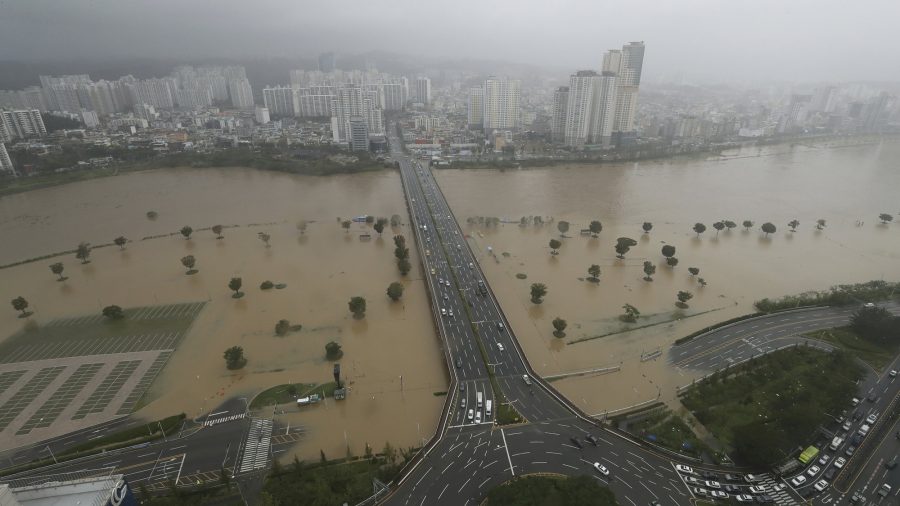SEOUL, South Korea—A powerful typhoon damaged buildings, flooded roads, and knocked out power to thousands of homes in South Korea on Monday after battering southern Japanese islands. More than 20 people were injured.
The Korea Meteorological Administration warned of “very heavy rain and very strong winds” as Typhoon Haishen, packing maximum winds of 126 kilometers (78) miles per hour, made landfall in the southeastern port city of Ulsan. The weather agency said the typhoon, the third to hit the peninsula in as many weeks, was weakening and will likely be downgraded to a tropical storm within 24 hours.
Cars struggled to navigate flooded roads in Ulsan and other coastal cities such as Busan, Sokcho, and Gangneung. Emergency workers scrambled to clean up toppled trees and damaged traffic signs, buildings, and other structures. The Ministry of the Interior and Safety said a person in Busan was lightly injured after a car flipped in strong winds, but it didn’t immediately provide further reports of casualties.
At least 318 flights in and out of the southern island province of Jeju and across the mainland were canceled, according to the Korea Airports Corporation. Some bridges and railroad sections were shut down, thousands of fishing boats and other vessels were moved to safety, and more than 1,600 residents in the southern mainland regions were evacuated due to the possibility of landslides and other concerns.

Workers as of Monday morning completed restoring power to 11,523 of the 17,620 households that had lost electricity in the southern mainland areas and Jeju.
Haishen, which means “sea god” in Chinese, plowed through Okinawa and other southern Japanese islands over the weekend. Traffic was still paralyzed in places; bullet trains were suspended and most domestic flights in and out of southwestern Japanese airports were canceled Monday.
Japan’s Fire and Disaster Management Agency said at least 20 people, including two seriously, were injured. As of Monday morning, about half a million homes were still out of power. NHK public TV said four people were missing in Miyazaki.
The storm by late Monday was expected to reach North Korea’s northeastern region, which was battered by Typhoon Maysak last week, inflicting further pain on an economy ravaged by U.S.-led sanctions, border closures amid the coronavirus pandemic, and chronic food shortages.

The North’s state media said leader Kim Jong Un visited typhoon-stricken areas, fired a top regional official for poor readiness, and promised to send 12,000 workers from capital Pyongyang to help with recovery efforts. The North said Maysak destroyed more than 1,000 houses and inundated public buildings and farmland. It didn’t immediately report any casualties caused by Haishen.
Maysak damaged roads and buildings and left at least one person dead in South Korea. In addition, a livestock cargo ship sank off Japan’s coast as Maysak passed. Two of its 43 crew members were rescued and one body was recovered before the search was halted because of Haishen. The ship was transporting 5,800 cows from New Zealand to China.
By Kim Tong-Hyung and Mari Yamaguchi


